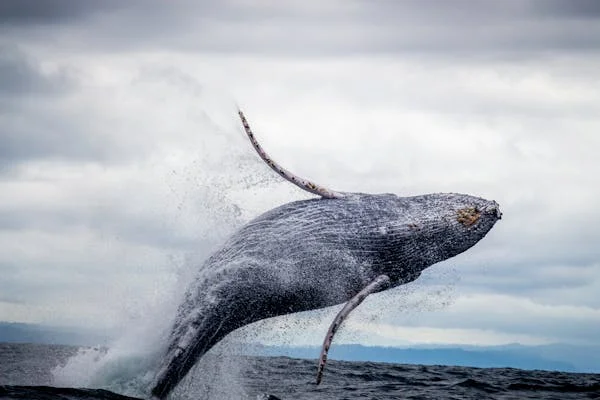Introduction
Blue Whale Bitten in Half are known for their colossal size, with some reaching lengths of over 100 feet and weighing as much as 200 tons. These physical characteristics make them incredibly impressive but also more vulnerable to certain types of injuries, such as ship strikes and large predator attacks. Understanding these features is crucial to grasping why certain events, such as being severed in half, are both rare and dangerous for these majestic creatures.
Size and Strength: Natural Defenses of Blue Whales
A Blue Whale Bitten in Half immense size is its primary defense mechanism. Their size alone makes them a formidable force in the ocean. However, despite this, large marine predators such as orcas and even great white sharks still pose a threat to younger or weaker blue whales. These animals have been known to attack blue whale calves, but attacks on fully-grown adults are rare due to the whale’s sheer size and power.
Vulnerability Due to Slow Movement
While Blue Whale Bitten in Half are capable of moving at considerable speeds, they are not known for being exceptionally fast swimmers. Their slower pace may make them more vulnerable to ship strikes and other dangers in heavily trafficked areas, such as shipping lanes.
Blue Whale Bitten in Half Severance on Marine Life
When a blue whale is found severed in half, the ecological consequences are profound. As one of the largest creatures in the ocean, blue whales play an integral role in marine ecosystems. The death of a whale, especially under such tragic circumstances, impacts numerous species that depend on their carcasses for nutrients.
Scavenger Species and Their Role in Whale Carcasses
After a blue whale dies, its carcass serves as a critical food source for a variety of marine species. Scavengers such as sharks, deep-sea fish, and other marine organisms feast on the remains, benefiting from the whale’s enormous size. In some cases, if the whale’s body is severed due to scavenger activity, it creates a larger food source, benefiting even more organisms.
Effects on Marine Food Chains
When large whales die, they contribute significantly to the marine food chain. The nutrients from their bodies, such as nitrogen and phosphorus, are released into the ocean, supporting plankton and other microscopic organisms. These nutrients eventually make their way up the food chain, benefiting a wide variety of marine life. However, the unnatural death of a whale due to human-caused injuries might disrupt this cycle, affecting other species that rely on whale carcasses for nourishment.
The Role of Conservation in Preventing Blue Whale Severance
Given the immense size and importance of blue whales in maintaining ecological balance, it is critical to protect them from potential threats. Conservation measures aimed at preventing ship strikes, reducing pollution, and enforcing regulations are all essential in ensuring the survival of blue whales.
Efforts to Reduce Ship Strikes
One of the primary human-related threats to blue whales is ship strikes. To prevent these incidents, maritime organizations have worked on developing safe shipping lanes, reducing ship speeds in whale-heavy areas, and using technology to detect whale movements. International organizations, including the International Whaling Commission, have initiated guidelines to protect these creatures from collisions.
Addressing Pollution and Habitat Loss
Pollution in the form of plastic, oil spills, and chemical contaminants is another significant threat to blue whales. Conservation groups have been focusing efforts on reducing marine pollution, which can harm blue whales both directly and indirectly. Habitat loss, caused by increasing human activity in the ocean, also poses a threat to the long-term survival of blue whale populations.
Studying Blue Whales: Ongoing Research and Technology
Advances in technology have made it easier for researchers to study blue whales and gain a better understanding of their behavior, migratory patterns, and potential threats. This research is essential in identifying areas where conservation efforts should be concentrated.
Use of Satellite Tracking for Whale Movement
Satellite tracking technology allows scientists to monitor the movements of blue whales, giving them crucial data on where these whales are located and where they might be vulnerable to ship strikes. By tracking their movements, conservationists can work to create safer shipping routes and intervene when necessary to avoid collisions.
Genetic Research to Improve Conservation Efforts
Genetic studies of blue whales can offer insights into their population dynamics and help scientists identify genetically distinct groups of whales. This can be particularly useful in understanding the health of different populations and ensuring that conservation efforts are tailored to protect these groups.
Future Outlook for Blue Whale Bitten in Half
The future of blue whales remains uncertain, as they continue to face significant threats. However, ongoing efforts from governments, conservation organizations, and researchers are making progress in improving the survival prospects for these majestic animals.
Positive Trends in Conservation
There has been some good news regarding blue whale populations in recent years. Efforts to reduce hunting, prevent ship strikes, and address marine pollution have led to a gradual increase in blue whale populations. These efforts show that, with proper protection, these incredible creatures can survive and thrive in the oceans.
Ongoing Challenges and Risks
Despite these positive trends, blue whales still face significant threats from human activities. Increased shipping traffic, oil exploration, and climate change all continue to pose risks to blue whale populations. As these creatures are slow to reproduce, it will take decades for their numbers to recover fully.
Conclusion:
The case of blue whales being severed in half is a rare but serious reminder of the dangers that these magnificent creatures face in the modern world. Whether it is a result of human activities, such as ship strikes and pollution, or natural causes, such as scavenger activity, these events underscore the need for ongoing conservation efforts.
It is essential that we take immediate action to protect blue whales and their habitat. This includes reducing pollution, protecting their migration routes, and ensuring that they are not harmed by human activities. Only through collective action can we safeguard the future of these incredible creatures and the vital role they play in maintaining the health of our oceans.
FAQs About Blue Whale Bitten in Half
What causes a Blue Whale Bitten in Half to be severed in half?
Blue whales may be severed due to ship strikes, predator attacks, or scavenger damage after death.
How are blue whale populations protected?
Blue whale protection efforts focus on reducing ship strikes, addressing pollution, and enforcing marine conservation regulations.
What impact does a severed whale have on the ocean ecosystem?
A severed whale may disrupt nutrient cycles and affect scavenger species that rely on whale carcasses for food.
Why are blue whales so important to the marine ecosystem?
Blue whales contribute to the nutrient cycling in the ocean, supporting the entire marine food chain.
What can be done to prevent blue whale severance?
Reducing ship traffic, creating safe shipping lanes, and minimizing pollution are key measures to prevent injuries to blue whales.
How can satellite tracking help blue whale conservation?
Satellite tracking allows researchers to monitor blue whale movements and avoid collisions with ships, aiding in conservation efforts.







